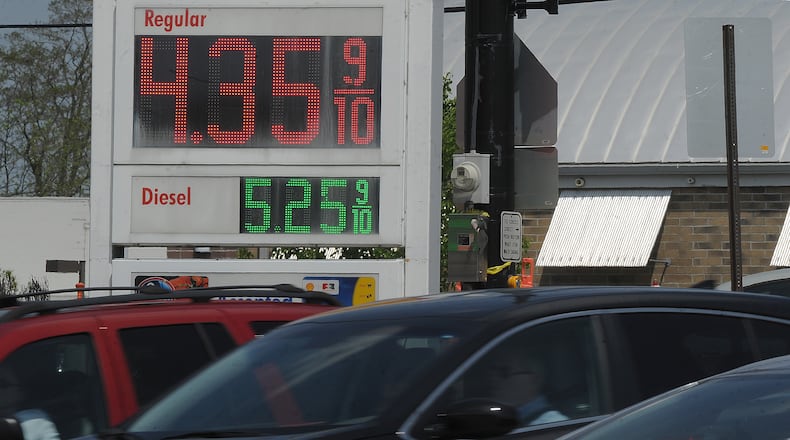In Ohio, prices rose 23 cents from the prior week to reach $4.18 per gallon. Dayton ($4.17 per gallon), Springfield ($4.18) and Cincinnati ($4.15) saw prices jump by 30 cents, 33 cents and 26 cents, respectively, in the course of a week.
Some stations in the region saw prices skyrocket by more than 30 cents to as much as $4.35 by Tuesday.
Credit: Bill Lackey
Credit: Bill Lackey
Locally, Miami Valley prices are at an average of $4.17, exceeding the $4.16 record set for the area on May 4, 2011, according to Kara Hitchens, spokeswoman for AAA Miami Valley.
Decreased supply of global oil and increased demand for it have caused the rising cost at the pump, with prices hovering near $100 per barrel last week and losing in on $110 this week, according to AAA. With the cost of oil accounting for more than half of the pump price, more expensive oil means more expensive gasoline, AAA said.
Higher prices come on the verge of the summer travel season, which makes the timing difficult for many residents.
“Folks told us back in March that these two years, two-and-half years have been really tough and they’re ready to travel again,” Hitchens said. “They’re anxious to get back out there.”
But based on surveys of local AAA members, gas that costs $4 or more per gallon will force motorists to make decisions about their driving habits, Hitchens said.
“There are a number of things that folks will do, such as combining trips and not running out each and every time (the need arises),” she said. “Perhaps people will have to make some hard decisions surrounding vacation, maybe not to go as far or stay as long at their destinations, maybe eat in instead of eating out every single meal.”
Prices could continue to climb through Memorial Day as summer road trip season begins and oil prices remain volatile, according to Patrick De Haan, head of petroleum analysis at GasBuddy.com.
“Ohio, along with Great Lakes states, are often a price leader, and this week we saw prices jump as oil last week surged $9 (a barrel),” De Haan told this news outlet Tuesday. “Ohio will likely see prices start dropping the earliest as well, so long as oil’s losses this week are not reversed quickly.”
Quick price jumps happen when stations ignore minor fluctuations in the market on a daily basis. Instead, most stations undercut each other a penny or two each day until they run out of margin.
“That is, until they’re no longer making any money and then a retailer will raise their price 25 to 40 cents a gallon to pass along any price difference and to restore their margin to maybe 15 to 20 cents a gallon,” De Haan previously said.
Fuel prices nationwide decreased slightly after spiking in March, as the situation between Russia and Ukraine continued but simmered, De Haan said in his blog. Prices began to rise again over the last few weeks as the odds of the European Union sanctioning Russian oil increased, he said.
Total domestic gasoline stocks decreased by 2.2 million barrels to 228.6 million barrels last week, according to new data from the Energy Information Administration. However, gasoline demand increased slightly from 8.74 million barrels perday to 8.86 million barrels per day.
Meanwhile, “supply chain challenges are impeding the return of oil production in a noticeable way,” De Haan said Tuesday.
Prices for gasoline and diesel continue to climb “with little power to harness them as the imbalance between supply and demand globally continues to widen with each passing day,” De Haan said.
“Russia’s oil increasingly remains out of the market, crimping supply while demand rebounds ahead of the summer driving season,” he said. “There’s little, if any, good news about fuel prices heading into summer, and the problem could become worse should we see an above average hurricane season, which could knock out refinery capacity at a time we badly need it as refined product inventories continue to plummet.”
About the Author


